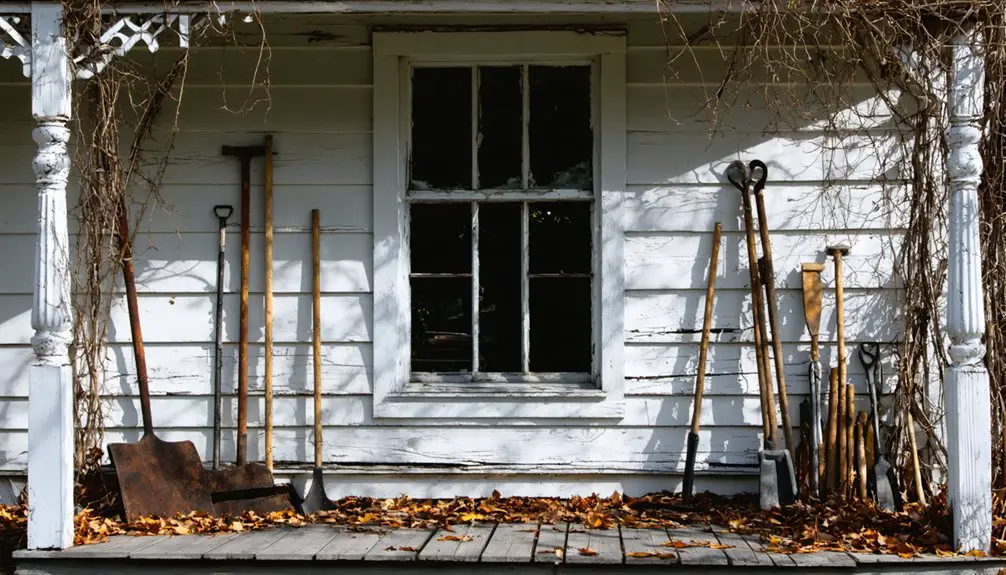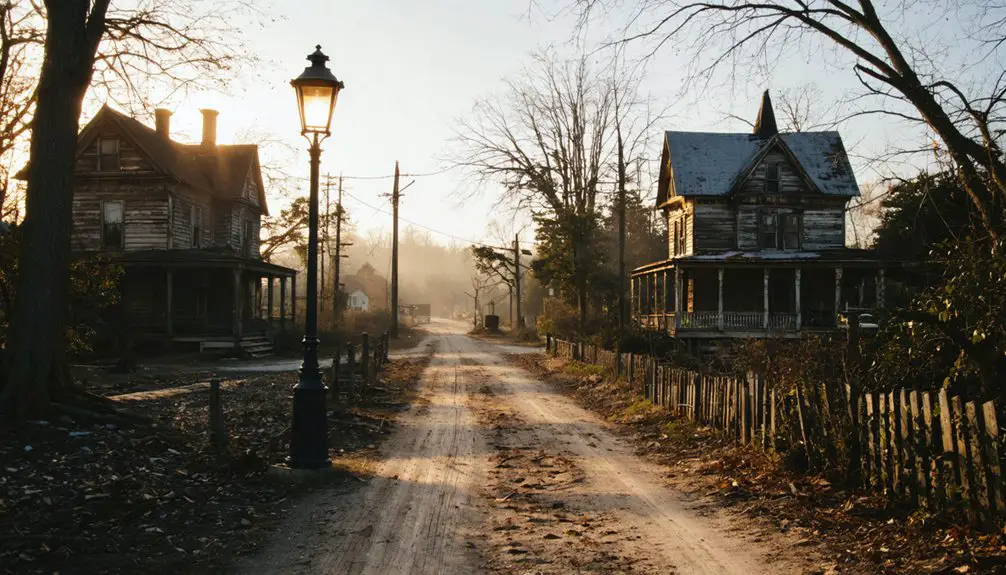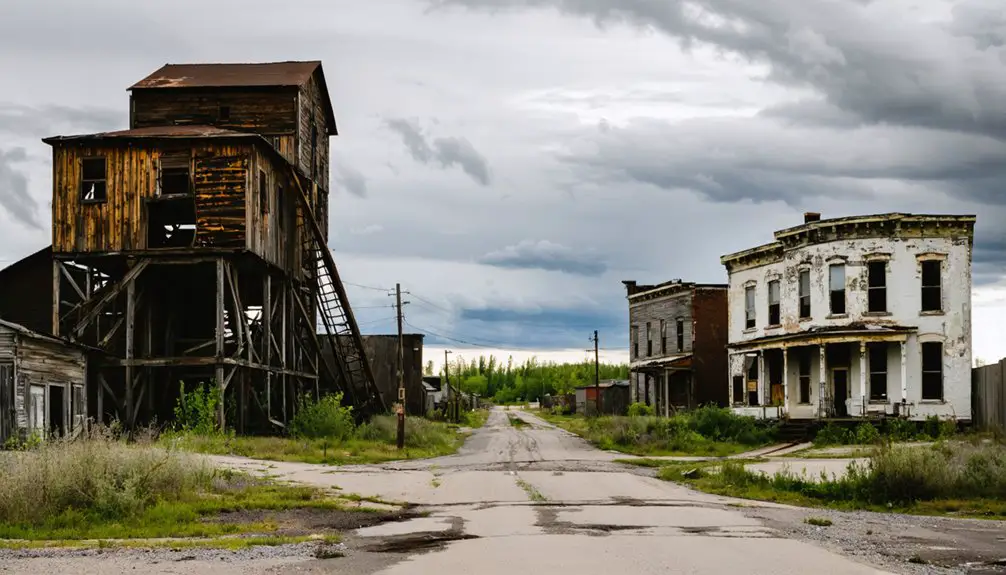You’ll find Eckley Miners’ Village, an 1854 coal mining settlement turned living museum, nestled in Pennsylvania’s anthracite region. This remarkably preserved company town showcases over 200 original structures, including miners’ double houses, churches, and the company store. It’s a tribute to the immigrant workers who shaped America’s industrial revolution, living under strict company control with basic amenities and scrip payment systems. Step back in time to uncover the authentic stories of Pennsylvania’s coal heritage.
Key Takeaways
- Eckley is not a true ghost town but a living history museum preserving over 200 original structures from a 19th-century coal mining community.
- Established in 1854 as a company mining town, Eckley maintains authentic double houses, churches, and industrial buildings from its operational period.
- The site features original miners’ homes, complete with period-accurate furnishings, showcasing the harsh living conditions of Pennsylvania’s coal mining era.
- Transformed into a museum in 1970, Eckley offers guided tours of historic buildings and educates visitors about anthracite mining heritage.
- The village remains inhabited by some residents while functioning as an educational facility, preserving the authentic character of a coal company town.
The Rise of a Coal Mining Community
When America’s industrial revolution demanded abundant fuel in the mid-1800s, Eckley emerged as a purposefully designed coal mining settlement in Pennsylvania’s rich anthracite fields.
You’ll find its 1854 origins rooted in strategic community development, with the mining company constructing about 130 basic dwellings by 1860 to house essential workers near the collieries. These stark homes lacked basic amenities like running water and plumbing.
The town’s immigrant integration shaped its cultural identity as waves of newcomers arrived. First came the Irish, establishing the Immaculate Conception Church, followed by eastern Europeans in the 1880s. The Pennsylvania Historical Commission now administers this historic site to preserve its rich heritage.
While they’d hoped to eventually return to farming in their homelands, most remained, cramming up to 30 people into double homes.
Dreams of returning home faded as immigrant families crowded together, making new lives in America’s coal country.
Despite the company’s tight control over housing, stores, and medical care, these determined immigrants carved out their own vibrant community spaces.
Life in a Company-Owned Town
You’ll find stark evidence of company control in every aspect of Eckley’s design, from the basic laborers’ dwellings that housed up to 30 people to the strategic placement of the company store and churches.
The double houses, built starting in 1854, lacked modern amenities like running water and electricity, forcing workers to live in crowded, primitive conditions that reinforced their dependence on company services. The Pinkerton Detective Agency maintained surveillance of the miners during the turbulent 1870s period following worker strikes. Only eight double houses remain today from the original ten that were constructed.
The town’s layout itself served as a control system, with housing quality and location directly tied to job status – better positions earned you improved accommodations farther from the mines, while laborers stayed packed into the eastern end’s cheaper dwellings.
Daily Control Systems
Life in Eckley revolved around three pillars of company control: work, commerce, and social order.
You’d find your every move monitored by a system of control mechanisms designed to limit worker autonomy. The company owned your house, regulated your work hours, and controlled where you shopped through their company store system. In Pennsylvania’s vast coal mining regions, these company towns became a dominant way of life.
You couldn’t escape their reach – they’d issue your wages in scrip, forcing you to buy overpriced goods at their stores.
The company’s watchful eyes extended into your social life, with guards monitoring gatherings and religious services to prevent labor organizing. Even your choice of neighbors was dictated by ethnic groupings intended to prevent worker solidarity.
If you stepped out of line, you’d face more than just losing your job – you could lose your home and your community standing. These oppressive conditions eventually led to the rise of the Molly Maguires who fought for workers’ rights.
Worker Housing Arrangements
The stark realities of company control extended directly into workers’ living spaces in Eckley. You’d find your housing assignment strictly determined by your job rank and ethnicity, with better homes reserved for mine foremen and first-class miners near the western end’s company store.
If you were among the laborers or immigrants, you’d be relegated to the eastern section’s cramped double-family dwellings.
Worker demographics shaped the town’s layout, with Irish families clustered near the Catholic church and other ethnic groups forming distinct enclaves. Housing occupancy often reached 30 people per unit as families took in boarders to supplement their income.
While you’d earn real U.S. dollars instead of scrip, you’d still face basic living conditions – no electricity, plumbing, or insulation in those red and black painted houses built for maximum company profit. The railroad tracks divided the village and served as a clear boundary between the wealthier Protestant residents on the west and poorer Catholic immigrants on the east.
Architecture and Historic Buildings
You’ll notice Gothic Revival elements in the well-preserved St. James Episcopal Church, built in 1859 with its distinctive pointed arch windows and steep-pitched roof.
The original miners’ double homes, constructed from 1854-1860, remain standing today with their basic frame construction and later additions of Insulbrick siding that helped insulate the otherwise sparse dwellings. The buildings provide visitors with a period-furnished experience of how miners and their families lived in the late 1800s.
The workers’ housing reveals clear social hierarchies, from the mine owners’ larger homes at the western end to the smaller double houses for laborers at the eastern end, where up to 30 people might share a single structure. The town’s best-preserved buildings showcase the typical layout of an anthracite mining community in America.
Gothic Design Elements
While humble workers’ cottages dominated Eckley’s landscape, Gothic Revival architecture made bold statements through the village’s most prominent buildings in the 1860s.
You’ll find this architectural contrast most striking in Richard Sharpe’s grand residence, where Gothic symbolism proclaimed his status through:
- Cross-gabled roofs reaching skyward with dramatic vertical lines
- Ornate wooden trim and pointed arches defining windows and doorways
- Strategic positioning near other prestigious structures like the doctor’s office
The Immaculate Conception Church similarly embraced Gothic grandeur with its lancet windows and steep-pitched roof, serving as both spiritual beacon and cultural cornerstone for Irish immigrants.
These Gothic elements weren’t just architectural choices – they were powerful symbols of authority and social hierarchy in this company town’s carefully ordered world. The mansion’s pristine grounds with grass and trees provided a stark contrast to the coal-covered surroundings of miners’ homes.
Original Structures Still Standing
Beyond Gothic Revival‘s grand statements, Eckley’s architectural legacy lives on through roughly 200 original structures that paint a complete picture of 19th-century coal town life.
You’ll find miners’ homes, outbuildings, churches, and the iconic company store arranged precisely as they were in the 1854 town plan.
While preservation techniques have helped maintain these buildings’ structural integrity, you’re witnessing more than just preserved architecture.
The rebuilt coal breaker, modeled after its 1915 predecessor, stands as both a visual anchor and modern museum facility.
Original industrial buildings, along with remnants of tracks and coal car ruins, reveal Eckley’s authentic company town character.
The early sewer system and auxiliary structures like outhouses showcase how living conditions evolved in this remarkable anthracite mining community.
Mine Workers’ Housing Details
The miners’ homes of Eckley reveal a stark portrait of 19th-century working-class life, beginning with the construction of around 130 houses in 1854.
You’ll find basic wood-frame double homes throughout the village, built for maximum housing density, with each structure housing up to 30 residents including miners’ families and boarders.
- Uninsulated board-and-batten exteriors with no running water or electricity
- Four-room massed plans or saltbox styles reflecting pre-Civil War patterns
- Cultural adaptations visible in tenant improvements like chicken coops and room additions
These working-class dwellings tell a story of immigrant life, with Irish, Polish, and Eastern European families making incremental upgrades over time.
From Mining Village to Living Museum

Since its transformation in 1970, Eckley Miners’ Village has preserved an authentic slice of Pennsylvania’s anthracite mining heritage as a living history museum.
You’ll discover the compelling immigrant experiences of Welsh, German, Irish, and Eastern European families who once called this patch town home. The museum maintains original structures, including miners’ houses, churches, a doctor’s office, and the company store, providing a genuine window into 19th-century industrial life.
Through guided tours and educational programs, you’ll explore the economic impacts of the coal industry on these working families.
Expert guides illuminate how the coal industry shaped both the financial struggles and resilience of mining families’ daily lives.
The preserved buildings, many still showing their 1930s Insulbrick siding, tell the story of frugal company construction and gradual improvements.
Today’s admission fees help sustain this essential piece of regional industrial heritage.
Cultural Heritage and Labor Legacy
Eckley’s legacy as a company town reveals both the oppressive control of coal operators and the resilient spirit of immigrant miners who shaped Pennsylvania’s labor movement.
In this crucible of labor activism, immigrant workers from Ireland and Eastern Europe fought against harsh conditions while preserving their cultural heritage through ethnic churches and traditions.
- You can still see the stark contrast between ornate company officials’ homes and cramped workers’ double houses with basic Insulbrick siding.
- You’ll find evidence of cultural preservation in the Immaculate Conception Catholic Church, where Irish miners once gathered.
- You’ll discover the filming locations of “The Molly Maguires,” which brought national attention to miners’ struggles for basic rights.
Today’s museum stands as a powerful reminder of both exploitation and resistance in America’s industrial past.
Planning Your Visit to Eckley Today

Planning a memorable visit to this preserved anthracite mining village requires knowing when and how to make the most of your experience.
You’ll find the best village accessibility during summer months, when you can explore over 50 historic structures along a mile-long stretch. The museum welcomes visitors Wednesday through Sunday, 10 a.m. to 4 p.m., with reduced winter hours.
For $8 (less for seniors and youth), you’ll gain access to visitor amenities including guided tours, the museum’s exhibits, and entry to select buildings like the Catholic church and miner’s double house.
Plan about 2.5 hours to fully experience the site, and consider joining a Saturday guided walking tour for an extra $2.
Remember that some buildings aren’t handicap accessible, so you’ll want to plan accordingly.
Frequently Asked Questions
Are There Any Reported Ghost Sightings or Paranormal Activity in Eckley?
You’ll find documented ghost encounters near the infamous Stone Death Couch, where paranormal investigations reveal vanishing figures, a mysterious curse, and sightings of spectral women wandering through the trees.
What Happened to the Original Residents When the Mining Operations Ceased?
You’ll find that resident relocation scattered families as mining’s decline forced them to seek work elsewhere. Many moved to urban areas, while others stayed but faced poverty and limited opportunities.
Can Visitors Enter and Explore the Underground Mine Tunnels Today?
No, you can’t explore Eckley’s underground tunnels due to strict visitor regulations and mine safety protocols. Instead, you’ll find five other Pennsylvania mines offering guided underground tours for authentic mining experiences.
Does Anyone Still Permanently Live in the Houses at Eckley?
Yes, you’ll find current residents living in some houses today – they rent from the state commission. These families often have ancestral ties to the original miners, helping preserve Eckley’s historical significance.
What Filming Projects Have Taken Place Here Besides the Molly Maguires?
You’ll find many documentaries and educational films have captured Eckley’s history, though specific titles aren’t well documented. The village’s authentic mining-era buildings continue attracting historical productions seeking period-accurate filming locations.
References
- https://www.islands.com/1775818/eckley-miners-village-mining-town-pennsylvania-timelss-charm-largestbest-preserved-anthracite/
- https://eckleyminersvillage.com/about/
- https://pahistoricpreservation.com/preservationhappenshere-eckley/
- https://pabucketlist.com/exploring-eckley-miners-village-in-luzerne-county-pa/
- https://eckleyminersvillage.com/the-village/
- https://www.youtube.com/watch?v=saatqlfgXFA
- https://www.pa.gov/agencies/phmc/historic-sites-and-museums/pahistory2go/eckley-miners-village.html
- https://wynninghistory.com/2025/04/16/exploring-eckley-miners-village/
- https://www.loc.gov/item/pa4179/
- https://tile.loc.gov/storage-services/master/pnp/habshaer/pa/pa4100/pa4176/data/pa4176data.pdf



